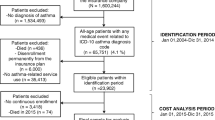Abstract
Objective: To determine the effect of age, disease severity and compliance on the annual primary-care cost of managing patients with asthma initially on British Thoracic Society British Guidelines on Asthma Management (BGAM) treatment steps 2/3 over 5 years.
Design and setting: A modelling study performed from the perspective of the UK’s National Health Service (NHS).
Study participants and interventions: A data set was created comprising 4519 patients with asthma in the DIN-link database who were prescribed twice-daily inhaled corticosteroids and who were on steps 2/3 between 1 January and 31 December 1993. These patients were followed over 5 years.
Methods: Asthma-related primary-care resource utilisation data obtained from the DIN-link database were stratified by patients’ age, compliance and BGAM treatment step. Unit costs at 1999–2000 prices were applied to the resource use estimates to determine the mean annual cost per patient.
Main outcome measures and results: High compliance with inhaled corticosteroids was not associated with a reduction in use of other primary-care resources, although the ratio of the number of prescriptions for inhaled corticosteroids to that for short-acting β2-agonists increased, suggesting that patients’ asthma was better controlled. Overall, the primary-care cost of managing a patient starting on steps 2/3 was found to be most strongly influenced by whether that patient moved onto steps 4/5 or continued to be managed on the same treatment step. If a patient continued to be managed at steps 2/3, costs were influenced in descending order of impact by compliance, previous BGAM step and the patient’s age.
Conclusions: Better compliance with inhaled corticosteroids is likely to lead to better asthma control and fewer asthma attacks. Notwithstanding this, increasing compliance is likely to increase primary-care costs. Consequently increasing healthcare expenditure may be the inevitable consequence of improving asthma control.









Similar content being viewed by others
References
Tavakkoli A, John Rees P. Drug treatment of asthma in the 1990s. achievements and new strategies. Drugs 1999; 57 (1): 1–8
The British Thoracic Society, the National Asthma Campaign, the Royal College of Physicians of London, et al. The British Guidelines on Asthma Management 1995: review and position statement. Thorax 1997; 52: S1–21
Neville RG, Pearson MG, Richards N, et al. A cost analysis on the pattern of asthma prescribing in the UK. Eur Respir J 1999; 14: 605–9
Hoskins G, McCowan C, Neville RG, et al. Risk factors and costs associated with an asthma attack. Thorax 2000; 55: 19–24
Bruce NJ, McCloskey EV, Kanis JA, et al. Economic impact of using clodronate in the management of patients with multiple myeloma. Br J Haematol 1999; 104: 358–64
Guest JF, Morris A. Community-acquired lower respiratory tract infections: the annual cost to the National Health Service. Br J Med Econ 1996; 10: 263–73
Flynn TN, Kelsey SM, Hazel DL, et al. Cost effectiveness of amphotericin B plus G-CSF compared with amphotericin B monotherapy: treatment of presumed deep-seated fungal infection in neutropenic patients in the UK. Pharmacoeconomics 1999; 16 (5 ii): 543–50
Guest JF, Munro VL. A comparison of the economic impact on the National Health Service of ramipril and enalapril in the treatment of essential hypertension. Br J Med Econ 1996; 10: 303–14
Plumb JM, Guest JF. The economic impact of tibolone compared to continuous-combined HRT in the management of postmenopausal women with climacteric symptoms in the UK. Pharmacoeconomics 2000; 18 (5): 477–86
Netten A, Dennett J, Knight J. Unit costs of health and social care 1999. Canterbury: Personal Social Services Research Unit, University of Kent, 1999
Monthly Index of Medical Specialties (MIMS). 1999–2000 eds. London: Haymarket Publications, 1999/2000
Drug tariff. February 1998. London: The Stationery Office, 1998
National Asthma Campaign. National asthma audit 1999/2000. Cookham, Berkshire: Direct Publishing Solutions, 1999
Majeed A, Ferguson J, Field J. Prescribing of beta-2 agonists and inhaled steroids in England: trends between 1992 and 1998, and association with material deprivation, chronic illness and asthma mortality rates. J Public Health Med 1999; 21 (4): 395–400
Audit Commission. A prescription for improvement. London: HMSO, 1994
Shelley M, Croft P, Chapman S, et al. Is the ratio of inhaled corticosteroid to bronchodilator a good indicator of the quality of asthma prescribing?: cross sectional study linking prescribing data to data on admissions. BMJ 1996; 313 (7065): 1124–6
Griffiths C, Naish J, Sturdy P, et al. Prescribing and hospital admissions for asthma in east London. BMJ 1996; 312: 481–2
Donahue JG, Weiss ST, Livingston JM, et al. Inhaled steroids and the risk of hospitalisation for asthma. JAMA 1997; 277: 887–91
Frischer M, Heatlie H, Chapman S, et al. Should the corticosteroid to bronchodilator ratio be promoted as a quality prescribing marker? Public Health 1999; 113 (5): 247–50
Noeker M. Psychological aspects of adherence to inhaled glucocorticosteroid therapy. Clin Asthma Rev 1997; 1: 129–38
Rand CS. Patient and regimen-related factors that influence compliance with asthma therapy. Eur Resp Rev 1998; 8: 270–4
Legorreta AP, Christian-Herman J, O’Connor RD, et al. Compliance with national asthma management guidelines and specialty care: a health maintenance organization experience. Arch Intern Med 1998; 158: 457–64
Trueman P, Drummond M, Hutton J. Developing guidance for budget impact analysis. Pharmacoeconomics 2001; 19 (6): 609–21
Acknowledgements
The authors thank Schering-Plough for their financial support of this study. The authors have no conflicts of interests that are directly relevant to the content of this manuscript.
Author information
Authors and Affiliations
Corresponding author
Rights and permissions
About this article
Cite this article
Das Gupta, R., Guest, J.F. Factors Affecting UK Primary-Care Costs of Managing Patients with Asthma over 5 Years. Pharmacoeconomics 21, 357–369 (2003). https://doi.org/10.2165/00019053-200321050-00007
Published:
Issue Date:
DOI: https://doi.org/10.2165/00019053-200321050-00007



